Shuttle XPC ST20G5 (cont'd)
Construction
If you read what we had to say about the construction of the SN95G5, the same applies to the ST20G5. We did leave out a few items, however, as that gives us a bit of material that we can use here. Naturally, what we say here applies to both socket 939 G5 models.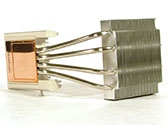 |
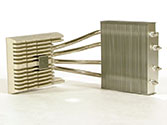 |
 |
| Click on images to enlarge. | ||
One of the impressive aspects of the G5 design is the ICE (Integrated Cooling Engine) heatpipe. We won't go into the details of how it all works, but the principle of a heatpipe is to use a liquid within the pipes. As the liquid heats up, it begins to boil and moves through the pipe to the radiator. There, it gets cooled down and condenses back into a liquid. That's a basic overview of what should happen, at any rate. There are a variety of ways to design a heatpipe, and all we can say for sure is that the heatpipe in the G5 appears to cope with the CPU heat output with no difficulties. A smooth copper base rests atop the CPU, with aluminum pipes leading up to an aluminum radiator. The radiator is cooled by a relatively large 92mm fan, which also serves as a case fan. While it may not be sufficient for extreme overclocking, it is a quiet design that performs well with our stock SFF testing configuration.
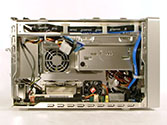 |
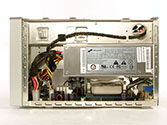 |
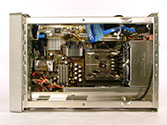 |
| Click on images to enlarge. | ||
One minor difference with the ST20G5 is the presence of several heat sinks on various chips. The Xpress 200 only functions as the North Bridge of the motherboard, with a ULi 1573 South Bridge providing additional features. The ATI chipset has active cooling while two other chips use passive cooling. One of these is almost certainly the ULi 1573, although we're not sure about the other. Small, passive heat sinks aren't a bad thing, as they do help dissipate heat from components and they don't add to the noise levels. The small fan on the North Bridge did add to the perceived noise, however. It doesn't really show up on the noise benchmarks, but the noise from the ST20G5 seemed higher in pitch, which humans often perceive as being louder even though it may be at the same dB level.
Setup
The hardware setup for the ST20G5 is unchanged from other G5 models. It requires roughly 15 to 20 minutes to assemble the system. Again, the documentation provided by Shuttle makes the process easy enough for just about anyone to follow. Once the hardware is installed, things become slightly different, based on the model and platform. |
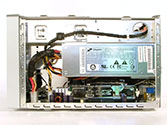 |
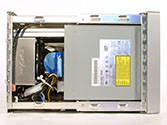 |
| Click on images to enlarge. | ||
The BIOS of the ST20G5 is similar to other Shuttle designs, although the use of the ATI chipset does change things a bit. For instance, there are a few items related to the integrated graphics. In the desktop market, there are only a few Xpress 200 motherboards currently available, one being a micro-ATX model from MSI. While it is a good motherboard, one area that is absent is overclocking support. Some have speculated that the reason why MSI didn't include overclocking options was due to the ATI chipset, but Shuttle includes a standard array of overclocking and tweaking settings. We'll discuss how it does in overclocking later.
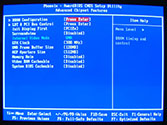 |
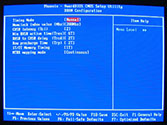 |
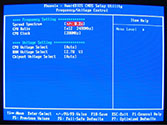 |
| Click on images to enlarge. | ||
With the hardware and BIOS configured, it's time to install Windows XP. We were disappointed to discover that the SATA controller on the ULi 1573 is not supported by Windows XP. We received the standard "no hard drives found" error message. Rebooting and using F6 along with the provided floppy disk does fix the problem, but that means that a floppy drive is necessary in order to install Windows. We prefer chipsets like the nForce 4 and i915/925 that can support XP installations without a floppy drive. Unfortunately, that's one of the common problems when using North and South Bridges from different manufacturers.
Once XP is installed, it's time to install drivers once again. As usual, a CD provides the necessary files. For the ST20G5, there are five items to install: the ATI graphics driver, ULi 1573 drivers, both an HD audio bus driver as well as the audio driver itself (you have to install the chipset drivers and reboot before you can do this), and finally, the network driver. Here is where something like Aopen's EZInstall interface would really be welcomed, as each of the driver setup programs wants to reboot the PC after it finishes installing, and at least two reboots are required. We shouldn't really count the graphics driver, as it's something that you normally need to install separately anyway, and there is sure to be an updated version of the driver from ATI by the time you purchase an ST20G5.
Power Problems
As a final comment on the setup process, we mentioned before that our PowerColor X800Pro card required a 6-pin PCIe connection. Even with an adapter that converts two 4-pin molex connections into a 6-pin PCIe connection, things didn't work properly. The system wouldn't even boot when we plugged in the adapter initially. Leaving the PCIe connector off of the PowerColor card didn't work either, as the monitor would simply display an error message stating that the power adapter was required.We thought that the problem might have been somehow related to insufficient power, but we eventually did get things to work by doing some research online. It turns out that the PCIe 6-pin connection should have three +12V pins on one side and three ground pins on the other side; the $5 cable that we bought at a local store had one of the +12V wires connected to ground, causing the system to refuse to boot. Our advice is to wait for an updated power supply from Shuttle, purchase a PCIe graphics card that doesn't require a separate power adapter, or make sure that you have a proper adapter cable. (This same problem could have easily occurred on the SN25P or 330P testing, so just make sure that you have a PCIe power cable for your graphics card if you need it.)
Noise, Heat and Performance
Noise and heat levels were very similar to that of the SN95G5. That's not too surprising, as the only major difference is the chipset and a PCIe X800Pro instead of an AGP version. Performance differences are also relatively minor - a case of "win some, lose some", but rarely by more than a small margin. We definitely don't see any major performance issues with the ATI/ULi chipset combination, which is welcome news.The 3D performance of the IGP still pales in comparison to even a mid-range card like the $90 6600 or X600 Pro. It's basically on par with an X300SE. For non-gamers, this isn't a problem, but even casual gamers will end up disappointed when attempting to play the latest 3D games, as you'll see in our benchmarks. We would reserve the use of the IGP for non-3D applications or games that are more than two years old.
Overall Impressions
As with the SN95G5, we like the overall design of the ST20G5. However, there are still areas where we prefer the nForce 3 Ultra chipset to the ATI Xpress 200. Overclocking is the biggest benefit of the nForce 3/4 chipsets, as the ATI/ULi chipset combination was far more limited. The SATA controller in the nForce chipsets is also preferred because we don't like dealing with floppy disks just to get SATA support working in Windows. Neither issue is a show stopper for most people, but they are shortcomings. The ATI chipset does include integrated graphics of a decent quality, and for users who don't demand a lot from their graphics, it's a nice addition.Would we recommend the ST20G5 right now? Mostly - it's attractive, quiet, and performance is right up there with competing models. The ST20G5 isn't a perfect design, but there is sure to be a market for a SFF with integrated graphics and a DVI connector. The price is a little higher right now than what we would like (at around $350) - you could buy the SN95G5 and a reasonable quality discrete graphics card for less money - but we expect that there's a bit of added inflation right now because the product is newer. It should probably settle into the $325 price range, which is more common for a modern SFF design.
The biggest problem that we encountered with the ST20G5 was the power supply and/or support for PCIe graphics cards that require a 6-pin power adapter. At present, the power supply is the same 240W model used in many other Shuttle cases. The problem is that most of those older designs are AGP models, and PCIe changes a few things. Adding a powerful graphics card - one that requires a 6-pin PCIe power connection - was more troublesome than what we would have liked. Shuttle has told us that they'll be shipping a modified PSU in the future with an integrated 6-pin PCIe power connection, so interested buyers should look for that. If you can't wait for an updated PSU, make sure you that get a PCIe power adapter that's wired properly.
Just in case you miss this in the conclusion, we'll also state it here. One area where the ST20G5 falls flat is overclocking support. While the BIOS lists up to a 255 MHz bus, we could not get a stable overclock above 205 MHz, no matter what we tried. We've seen some other reviews confirming our findings, so if you're looking at overclocking, this SFF is not for you. Above is a picture of our kludged attempt to get the system to overclock - we figured with the power draw being 235W max, overclocking might push the system into unstable territory. Alas, not even our Antec 350W PSU could get the system to overclock. This means that people hoping to grab a Venice or Winchester 3000+ and overclock to 3800+ speeds will want to look elsewhere. We've also heard about problems with the RAID controller, and this isn't something that we tested. We're not big fans of RAID, especially in a small case like the G5. If you're interested in a SFF with RAID support, we'd suggest going with the SN25P instead.


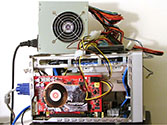








29 Comments
View All Comments
JarredWalton - Thursday, October 27, 2005 - link
Hopefully, anyone interested in the "promised" part 2 will find this post. I'm thinking of forgetting part 2 - I just have too much stuff to do! I've run some X2 benches/tests and can tell you this.The 330P, EQ3901-300P, SN25P, and ST20G5 all worked flawlessly with dual core - once the BIOS was updated. That last part is important, so let me elaborate.
For the 330P and ST20G5, the system WOULD NOT work with the BIOS I had (i.e. POST failed or complete system instability in the case of the 330P), so I had to switch back to a single core, update the BIOS, and then it worked. The 330P at first seemed to work, but I got frequent crashes and I couldn't even flash the BIOS with the X2 installed. If you have an extra 939 CPU, you should be fine; if you don't... well, I don't know if current 330Ps or ST20G5s are shipping with the latest BIOS or not, but I doubt it. (Ask Biostar/Shuttle for more information, I would suggest.)
Notably absent from the above list of X2 supported SFFs is the SN95G5v1/v2. I have v2, and it won't get past POST with an X2 processor. V3 will apparently work, but why buy an older AGP SFF these days? The Soltek worked fine, the SN25P was probably the best fit for the X2 plus a faster GPU, but the 330P was a lot more stable with the latest BIOS update. (The BIOS seemed to address several of the stability issues I had initially.) As far as I can tell, the USB + X2 issues of the SN25P have been resolved - I couldn't get any problems to occur, but then I may not be using the "right" USB device to cause a crash.
My pick overall remains with the SN25P. I successfully overclocked an X2 3800+ to 2.70 GHz in that system, where I could only reach 2.50 GHz in the 330P and 3901. Temperatures were a little lower than the 330P, cooling is better, but the system is larger. I'd say the 330P is now second overall in the recommendation list, and it does look pretty nice. The AGP units are not worth purchasing unless you can get them really cheap.
As nice as I think the ST20G5 looks, I feel the chipset used is complete garbage. Later ATI Xpress 200 chipsets (like the Crossfire stuff) are apparently much better, but the early Xpress 200 is at best equal to the like of ALi/ULi and SiS. Even VIA would be better (outside of integrated graphics performance) than the original Xpress 200. Overclocking remains essentially non-existent, and the smaller PSU (240W) will struggle with an X2 plus faster GPU. There's no way I would recommend spending $350 on the ST20G5.
Jarred Walton
SFF and Guide Editor
AnandTech.com
P.S. I'm skipping the 775 roundup as well, and will be moving on to later 775 systems for review. Basically, all of the 915/925 SFFs are outdated by the Pentium D, so there's no reason to purchase one (in my opinion). If you really want some brief thoughts on a specific 775 SFF, email me and I'll let you know. I have looked at several of the units, but putting together a 25000 word article on outdated hardware doesn't seem like a good use of time.
highlandsun - Tuesday, November 1, 2005 - link
Thanks for following up here, I just found this roundup while googling for ST20G5 reviews. My brother has an SN95G5v2 and we spent several hours one night trying to make it behave after updating to the latest BIOS. After the update Windows no longer saw his Logitech wireless trackball (but Linux still saw it just fine) plugged into the PS/2 port. We had to go back to the original BIOS that the thing shipped with. Unfortunately the original version doesn't support Cool'n'Quiet on the Winchester or Venice 3000+ that we plugged in (we had one of each), which was why we went looking for the BIOS upgrade in the first place.Anyway, he's using the SN95 for an HTPC, and I got interested in going the same route. But I was looking at the ST20 instead. The SN25P isn't a viable option because we're using Fusion HDTV tuner cards, and they're PCI only, no PCI-E version yet. I couldn't care less about AGP vs PCI-E for video in this case, as it's all overkill for simple media streaming. (The only key feature is making sure the video card supports DxVA for DVICO's MPEG decoder to work well.) But now it seems that none of Shuttle's current offerings are really suitable, since the ST20 really is too flawed in other areas.
Has anyone ever gotten an answer from Shuttle about why they would go to the trouble of using the Nforce3 Ultra but not using its integrated Gbit LAN??
dlevens - Sunday, September 4, 2005 - link
It would be nice to see a section on customer support. I have been extremely disapointed in Shuttle support for these SFF systems. I started with the SV25 and about 10 cubes later I am running the sn25p. I have to say I hate this thing. Also surprised to see there was no mention of some major issues with stability due to cheap or faulty sata cables. There are a ton of posts on sudhian about issues related to the sata cables. Curious if Anandtech saw any of these issues? http://forums.sudhian.com/messageview.aspx?catid=4...">http://forums.sudhian.com/messageview.a...amp;thre...Although, I would expect shuttle would send a well tested machine for a review site.
I also had a miserable time finding the most stable way to build the sn25p as far as drivers. Still not sure I have it right. This would be a great section to add in a review. I made a post here reguarding driver issues.
http://forums.sudhian.com/messageview.aspx?catid=4...">http://forums.sudhian.com/messageview.a...amp;thre...
One of my biggest complaints about the sn25p is sound. Was shocked to see the Via envy praised so much in the review. Maybe this is part of the driver issues I am having or could be the game I am currently playing, but sound is breaking up constantly on this thing. I have tried both drivers from VIA and both from shuttle. Anyone else playing Warlords IV on an sn25p and able to get your sound to work? I play warlords IV and run skype in the background for voice. Sound is garbled and breaks up.
Still looking for shuttle to be unseated in the sff market, would be nice to find some quality and stability to match the high price we pay for these sff systems. And a company who stands behind their product with great support would be icing on that cake.
Dennis
JarredWalton - Thursday, October 27, 2005 - link
Hey Dennis - I don't know if you'll see this, but I'll add it for others that might look. I obviously can't play all the games out there with each unit, so all I know is that the SN25P and the Via Envy did great on the tests I ran. The sound was also completely free of static, which is not the case for several of the others. The lack of static was far more important to me than other aspects of the sound system.Anyway, I didn't run into driver issues or SATA issues. I don't know if I just got lucky or what. I did a clean install of XP SP2, then I used the included CD to get sound and networking. I then downloaded the latest nF4 chipset drivers, along with graphics drivers for the ATI card I used, and I grabbed all the updates from Windows Update. Everything seemed to run fine.
artifex - Monday, August 22, 2005 - link
I think it'd be fun to compare these to Iwill's ZMAXdp, which is a dual-Opteron SFF. Not dual core, but dual processor. SFFTech says it's using nForce3 Pro as the chipset. It's also amazingly expensive, and has a silly little fin antenna :)JarredWalton - Thursday, August 25, 2005 - link
Iwill declined to send the current ZMAXdp when I emailed them, but they're working on an updated version for the future, so we'll see.Zak - Monday, August 15, 2005 - link
Frankly, each one of them has one single fault, just one, that makes, otherwise perfect box, useless for me... Some have the card readers up front that spoil the looks and I don't need them, some have no SPDIF out, some have 4 pin FireWire connectors, some are butt-ugly, some have on-board video. They'd be perfect otherwise if not for those single small problems. I haven't found a small factor case yet that would be perfect for me. So I'm sticking to towers for now.Zak
jopa25 - Saturday, August 13, 2005 - link
Hi, congratulations and thanks for that great review, in the first placeI'd have a little question about the the measurement of the noise levels of these SFF, is there any differences in the way noise was measured in relation with the former roundup (478/754 SFF roundup) ?
I expected the newer models to be quieter without GPU fan than the 478/754 SFF. However, according to the measurements, at 12 inches far, 4 out of the 5 478/754 SFF reviewed remained below 30dB, while the new models keep in a range from 37 to 46 dB in the same test. Quite a significant difference, isn't it?
As a part of an explanation, I guess the processor used in the last roundup (AMD Athlon 64 3800+ with Newcastle core) is not exactly wonderful at power saving, but should not be far from the Intel Pentium 4 3.0 used in the other roundup anyway.
So, the question is: Is there any reasonable explanation for these high levels of noise with fanless GPU, in comparison with those from the 478/754 roundup?
JarredWalton - Saturday, August 13, 2005 - link
I'm not entirely sure why the noise levels were higher. Part of it may be due to the time of year (winter vs. summer). The room that the systems were in was probably closer to 65 F for the last roundup, whereas I'd say close to 75 F for the current roundup. A 10 degree difference in room temperature would have a substantial impact, unfortunately. (If you compare the SN25P results to the March testing, it was substantially louder during stress testing.)I may not have measured in the exact same location relative to the last SFF roundup. I think I measured the socket 478 units from the front, which may have impacted things, and I moved some desks around which could have impacted scores as well. The rear of the SFFs are now closer to a wall than the old location, so noise reflecting off the wall might be changing the readings a bit.
I tried to be consistent with all the units in the roundup, but the use of differing CPUs makes it hard to say how they compare with the older models. I would say, however, that in typical use only the G5 units were at the same level as the last roundup. The 330P idled very low, but stress tests made it quite a bit louder. The SN25P and EQ3901 are both clearly louder than everything but the e-bot, which is roughly on the same level in terms of noise.
WooDaddy - Friday, August 12, 2005 - link
Jarod,GREAT Article. For quite some time I wanted to see a review with the SN25 and ST20 together. In the meantime, I bought a Mac Mini (quit screaming "traitor"). Out of curiousity, do you or anyone know the rated noise levels of the mini? It's dead quiet even at full CPU.
For you LGA775 SFF round-up, please don't forget to consider the Trigem Kloss PC (www.klosspc.com available at ZZF). Personally, it's the best looking SFF I've seen (better than the ASUS Spressos). I've been desperately looking for a review on that badboy.
Thanks